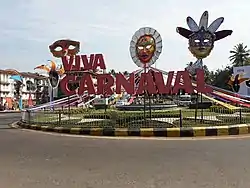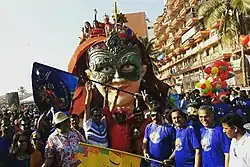| Goan Carnaval | |
|---|---|
    From Top left to right: City decorated for Carnaval, People dancing on streets, Floats during Carnaval | |
| Also called | Carnaval, Carnival |
| Observed by | Goans, communities worldwide |
| Type | Cultural |
| Significance | Celebration prior to fasting season of Lent |
| Begins | February |
| 2022 date | Afternoon, February 26 – midday, March 1 |
| 2023 date | Afternoon, February 18 – midday, February 21 |
| 2024 date | Afternoon, February 10 – midday, February 13 |
| 2025 date | Afternoon, March 1 – midday, March 4 |
| Frequency | Annual |
| Related to | Mardi gras |
Carnival in Goa, also called "Carnaval", "Intruz", "Entrado",[1] or (colloquially) "Viva Carnival" [2] refers to the festival of carnival, or Mardi Gras, in the Indian state of Goa. Though significantly smaller than the well-known Rio Carnival or the Portuguese Carnival of Madeira, the Goa Carnival is the largest in India and one of the few traditional celebrations of the Western Christian holiday in Asia.[3] The current version of the Goa Carnival was modelled after the Rio Carnival by a local musician named Timoteo Fernandes and imposed in 1965 to attract tourists. It has since turned into a major tourist attraction for the small state.[2]
Origin
While the roots of the Carnival in Goa date back to the introduction of Roman Catholic traditions during the Portuguese conquest of Goa, being celebrated since the XVIII century,[4] the festival itself fell into obscurity during the later days of colonialism, as Portugal's authoritarian regime known and is celebrated on the same day as Portugal Estado Novo limited freedom of assembly and press.[5]
After the end of Portuguese rule, the Brazilian version of the festival was imposed by Timoteo Fernandes in 1965, a Goan musician who modeled it after the famed Rio Carnival.[6][4] This was done to attract more tourism.[2] Today, the urban parade includes floats from local villages, commercial entities, and cultural groups. It is still organised in a very traditional manner, including by the staging of streetside local plays, in the coastal taluka of Salcete. According to the Government of Goa's Department of Tourism, the carnival is "Goa's most famous festival and has been celebrated since the 18th century."[7]
The Carnival usually starts off on Fat Saturday (known as Sabado Gordo) and concludes on Fat Tuesday (known as Shrove Tuesday), just before Ash Wednesday and the first day of the Catholic season of Lent. In Panjim, the capital of Goa, the festival is complemented by Grape Escapade, a local wine festival, and a dance at Samba Square in the centrally-located Garden of Garcia da Orta.[8]
According to local tradition, during Carnival Goa is taken over by King Momo, usually a local resident who presides over the festival during the four-day span.[9] King Momo traditionally proclaims the Konkani message Kha, piye aani majja kar (English: "Eat, drink and make merry"). In 2021 the King Momo for the Goa Carnival was Mr. Sixtus Eric Dias from Candolim.
Parade
The parade usually begins on Fat Saturday evening with a procession headed by King Momo. In 2021 the King Momo for the Goa Carnival was Mr. Sixtus Eric Dias from Candolim. Balloons, horse-drawn carriages, decorated bullock carts and elaborate floats are the highlights of the parade. The festivities during Goa Carnival include dancing troupes, revelers wearing masks and costumes, live music, sports competitions, floats and parades, and food and drinking.[10]
Dates
In 2022, the festival was celebrated from 26 February – 1 March.[11] In the urban areas, individual float parades were held in the Goan cities and towns of Panjim, Margao, Vasco and Mapusa.
See also
References
- ↑ "Its Goa - What is the story behind Goa Carnival?". itsgoa.com. 14 February 2017. Retrieved 4 March 2019.
- 1 2 3 "Oheraldo - The dawn of Viva Carnaval in Goa". heraldgoa.in. Retrieved 4 March 2019.
- ↑ Kamat, Prakash (25 February 2017). "Goa carnival kicks off". The Hindu. ISSN 0971-751X. Retrieved 24 August 2019.
- 1 2 Bhalla, Kartar Singh (2005). Let's Know Festivals of India. Star Publications. ISBN 978-81-7650-165-1.
- ↑ "Dictatorship, liberation, transition in the short fiction of three Portuguese-language Goan writers: Alberto de Menezes Rodrigues, Ananta Rau Sar Dessai and Telo de Mascarenhas". researchgate.net. Retrieved 4 March 2019.
- ↑ "How Goan is Goa's official Carnival?". Times Of India. 25 February 2023. Retrieved 14 March 2023.
- ↑ "Carnival". goatourism.gov.in. Goa Tourism. Archived from the original on 9 February 2017. Retrieved 13 March 2017.
- ↑ "Times of India - Red and Black Dance at Samba Square". The Times of India. 4 March 2014. Retrieved 4 March 2019.
- ↑ "The Wall Street Journal - Goa Ready for King Momo and Carnival". wsj.com. Retrieved 4 March 2019.
- ↑ "Goa Carnival 2018 | Festival in Goa". www.tourism-of-india.com. Retrieved 12 February 2018.
- ↑ "Goa Carnival 2018". goaleisure.com. Archived from the original on 30 October 2018. Retrieved 30 October 2018.